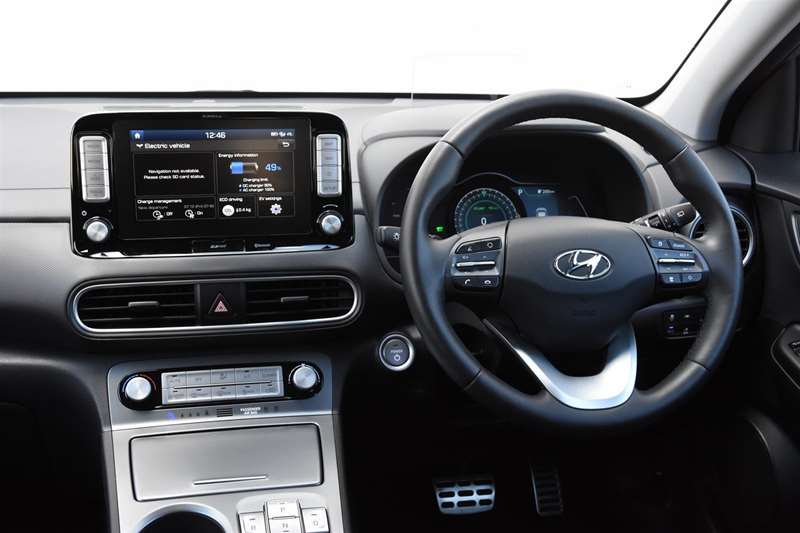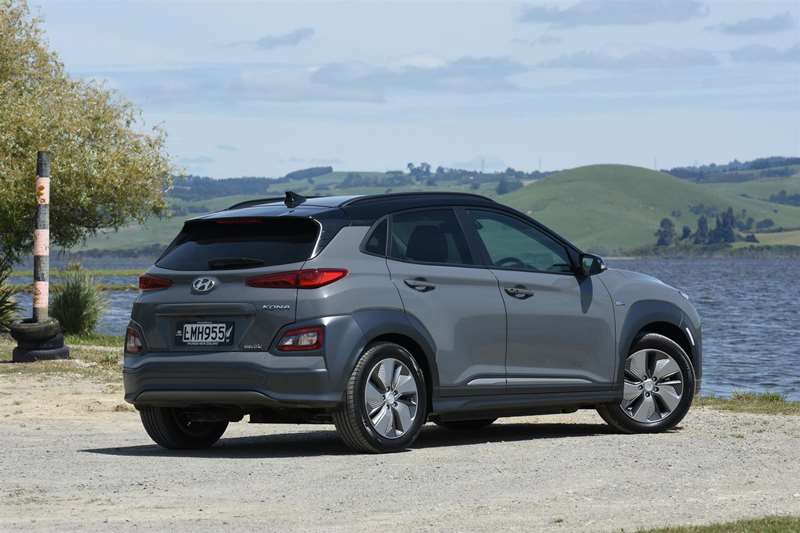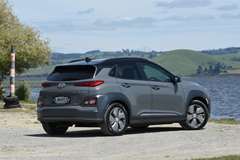Impressed by its promise of a 400km-plus real-world range, DavidThomson puts the Hyundai Kona EV Elite through its paces.
AS far as all-electric motoring in this part of the world is concerned, a vehicle that is (relatively) affordable and capable of travelling on a single charge from Dunedin to Invercargill, Queenstown, Wanaka, or perhaps even Christchurch is always going to be a potential game changer.
Enter the Hyundai Kona EV Elite with the promise of a 400km-plus real-world range.
The 64kWh EV comes in two identical powertrain guises: standard ($73,990) and Elite ($79,990). There’s also a 32kWh version with a 250km range on the horizon.
Both versions are packed with safety features — adaptive radar cruise control, lane-keeping assistance, driver attention alert, blind spot monitoring, rear cross traffic alert, and forward collision warning and avoidance systems — have keyless entry and push button start, along with climate control, and a centre colour touchscreen that includes Apple Car Play and Android Auto functionality.
The Elite, as supplied, adds several further items to justify its $6000 premium.
These include LED headlights, privacy glass, a larger centre touchscreen, premium sound system, wireless smartphone charging, leather trim, power operated heated/cooled front seats, heated steering wheel and a heads-up display. Sat-nav is the only obviously item missing.
Visually, the Kona EV is a stylish, compact SUV crossover, distinguishable from the regular Kona only by a solid patterned plastic that replaces the conventional air-intake grille at the front. The Kona EV is only offered as a front wheel-drive though, and it is not rated to tow anything.
Luggage space suffers compared with the petrol Kona, although a 332-litre boot capacity expanding to 1114 litres with the rear seats down should meet most needs.
The cabin is similar to that of the regular Kona, with a decent standard of fit, but more hard plastic than one might expect in a car carrying a $70,000-plus price tag. Perhaps the most telling differences are the four buttons — labelled R, P, N and D — that sit on the centre console in place of a gearshift — electric vehicles have no need for a gearbox.
So, what’s this gearbox-less, carbon-zero vehicle like to drive, and does it live up to its long-range aspirations?
A fleeting visit south to relocate the youngest member of the family for his summer job on Stewart Island seemed like the real-world test I was after: father and son driving from Dunedin to Bluff, with enough luggage to occupy the boot and rear seat, and back to Dunedin.
The test car showed a fully-charged 448km range when Drivesouth collected it. After running a couple of errands around town, a course was set for Invercargill.
Fears that the initial range prediction might prove significantly optimistic were fully dispelled by Milton. Reaching Invercargill less than two hours later, 215km had been covered and 225km of range was showing, confirming that the initial range prediction was close to spot on.
This was particularly impressive given that the test car was fully laden, and driven in a purposeful manner to complete the trip in a timely rather than economical fashion.
Performance-wise, running in standard mode, the Kona EV demonstrated ample pep for snappy highway passing, aided by the instant, maximum-torque response of its electric motor.
A sport mode is available to secure the sharpest response, but the extra performance this unleashes comes at the cost of smoothness and economy. At the other extreme, economy mode dulled performance too much for my liking on the open road.
Handling is vice-free, which is exactly what one would expect from a conventional compact SUV.
Equipped with energy-efficient tyres, the EV sacrifices some on-the-limit grip and steering feel.
In the absence of mechanical noise, wind and tyre roar are more obvious at highway speed but, overall, the Kona EV is a refined and quiet highway car.
Slowing to 50kmh, it was time to tap on the paddle controls, which adjust the amount of regenerative braking applied.
Recharging isn’t needed at this point, but with time to kill before we are due in Bluff, we take the chance to try the Invercargill ChargeNet facility.
There’s nothing complex about the recharge process: simply pull-up, plug in, wave the fob, select the 80% charge option (the maximum achievable on rapid charge) and hit start. With the system estimating it will take 28 minutes to boost from 50% to 80% we have time to grab a coffee and returning half an hour later find the recharge complete.
The 80% recharge enables a 350km range, which would have been enough to finish the onward journey to Bluff and head back to Dunedin, but I decided to grab another boost before returning to provide a comfort margin.
Back in Dunedin, it’s time for recharge three, this time at the Dunedin ChargeNet facility on St David St. With 93km showing, I opt for a shorter 24-minute shot to bring the charge up to half, and range to 220km.
Time isn’t the only factor that motivates the shorter charge: the Kona EV is about to be returned to Hyundai, and each of these recharges costs, with ChargeNet pricing at $0.25 per kWh plus $0.25 a minute. At least the billing, monthly once you’ve signed up for ChargeNet, is hassle free.
Which brings me to the difference in energy costs between the Kona EV and its 2-litre petrol engine equivalent.
Using the standard cycle consumption figures for each vehicle as a basis for comparison, the conventional Kona uses 7.2 litres of petrol for every 100km covered, which means it costs about $15 per 100km based on current pricing.
The Kona EV uses 14.3kWh of electricity which, based on the ChargeNet cost, works out at a little under $9. That’s a $6 saving per 100km, even using what — because it is convenient and quick — is probably the most expense means of recharging.
Home charging options involve either a purpose-installed $2000 wall box charger, or simply plug into a regular power point. The former should allow the Kona EV to regain full charge overnight, but the latter will take longer.
Realistically, those savings are never going to outweigh the purchase price of the Kona EV, which is more than twice as expensive as its petrol-powered equivalent.
But let’s weigh that against the feel-good, planet-friendly nature of zero-carbon motoring, and the reality of the Kona EV delivering this in a package that barely compromises every-day motoring at a price that isn’t into six figures, and the appeal is clear.
Photos: David Thomson












